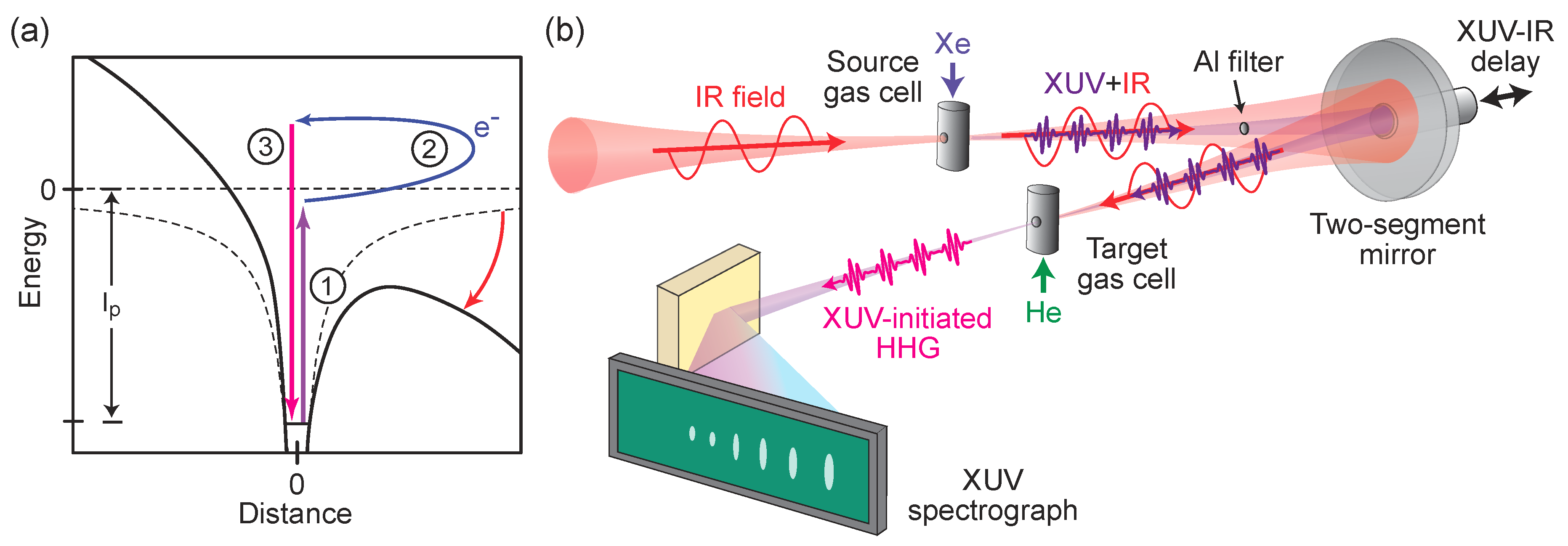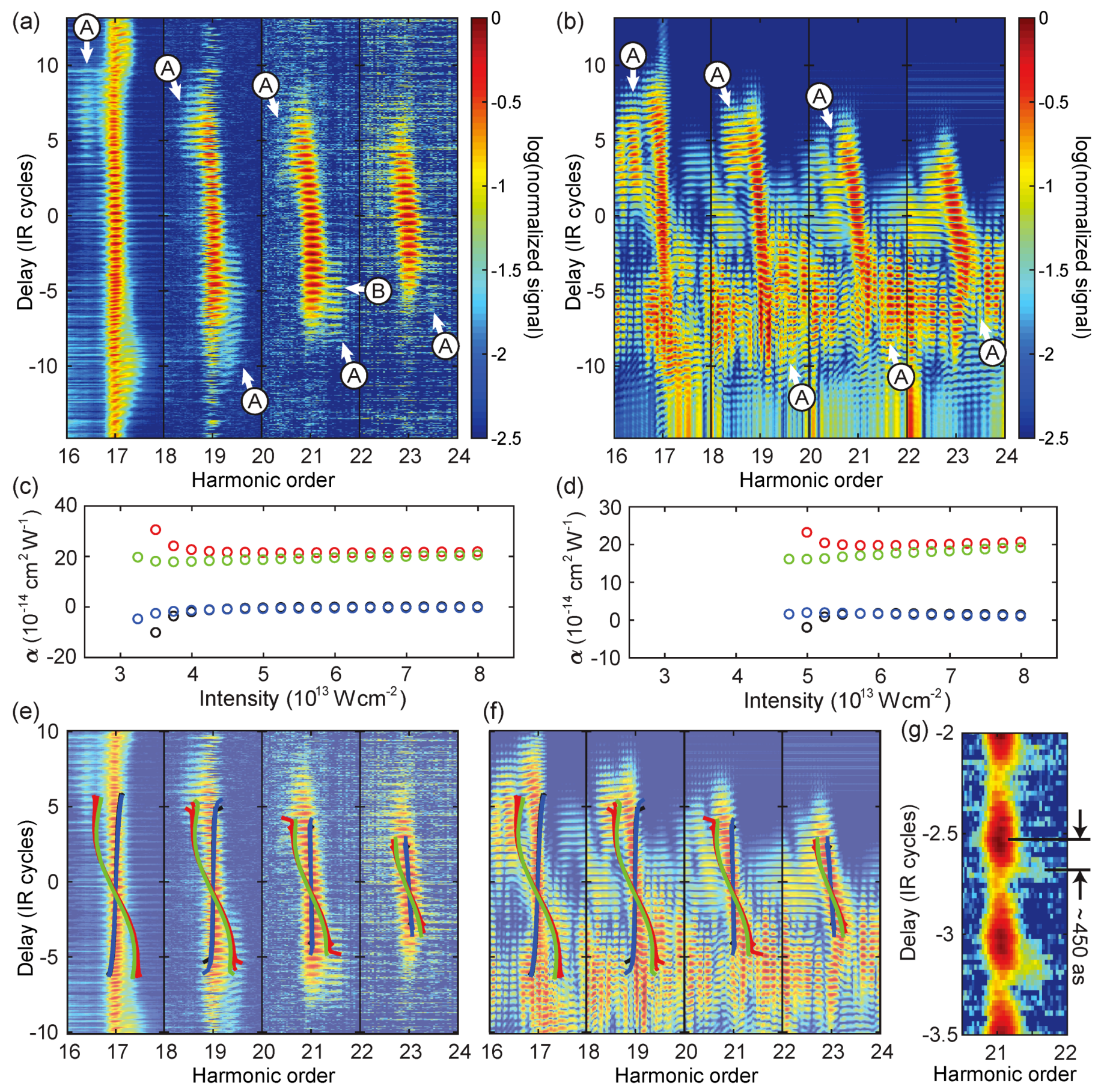The Role of Electron Trajectories in XUV-Initiated High-Harmonic Generation
Abstract
1. Introduction
2. Experimental Results
2.1. Experimental Setup
2.2. Energy- and Delay-Resolved XUV-Initiated HHG Spectra
3. Theoretical Methods
3.1. Coulomb-Corrected Three-Step Model
3.2. Numerical Integration of the Time-Dependent Schrödinger Equation
4. Discussion
4.1. Variation of the HHG Cutoff
4.2. Frequency Shifts of Short Trajectory Harmonics
4.3. Frequency Shifts of Long Trajectory Harmonics
4.4. Time Delay between Short and Long Trajectories
5. Conclusions and Outlook
Author Contributions
Funding
Acknowledgments
Conflicts of Interest
Abbreviations
| CCTSM | Coulomb-corrected three-step model |
| FWHM | Full-width at half maximum |
| H | Harmonic |
| HHG | High-harmonic generation |
| IR | Infrared |
| RABBITT | Reconstruction of attosecond beating by interference of two-photon transitions |
| TDSE | Time-dependent Schrödinger equation |
| XFROG | Cross-correlation frequency resolved optical gating |
| XUV | Extreme ultraviolet |
Appendix A. Harmonic Phase in the Coulomb-Corrected Three-Step Model
Appendix B. Pulse Parameters for the Numerical Integration of the TDSE
References
- Corkum, P.B.; Krausz, F. Attosecond science. Nat. Phys. 2007, 3, 381–387. [Google Scholar] [CrossRef]
- Krausz, F.; Ivanov, M. Attosecond physics. Rev. Mod. Phys. 2009, 81, 163–234. [Google Scholar] [CrossRef]
- Calegari, F.; Sansone, G.; Stagira, S.; Vozzi, C.; Nisoli, M. Advances in attosecond science. J. Phys. B Atom. Mol. Opt. Phys. 2016, 49, 062001. [Google Scholar] [CrossRef]
- Ferray, M.; L’Huillier, A.; Li, X.F.; Lompre, L.A.; Mainfray, G.; Manus, C. Multiple-harmonic conversion of 1064 nm radiation in rare gases. J. Phys. B Atom. Mol. Opt. Phys. 1988, 21, L31–L35. [Google Scholar] [CrossRef]
- Corkum, P.B. Plasma perspective on strong field multiphoton ionization. Phys. Rev. Lett. 1993, 71, 1994–1997. [Google Scholar] [CrossRef] [PubMed]
- Schafer, K.J.; Yang, B.; DiMauro, L.F.; Kulander, K.C. Above threshold ionization beyond the high harmonic cutoff. Phys. Rev. Lett. 1993, 70, 1599–1602. [Google Scholar] [CrossRef]
- Lewenstein, M.; Balcou, P.; Ivanov, M.Y.; L’Huillier, A.; Corkum, P.B. Theory of High-harmonic Generation by Low-frequency Laser Fields. Phys. Rev. A 1994, 49, 2117–2132. [Google Scholar] [CrossRef]
- Bellini, M.; Lyngå, C.; Tozzi, A.; Gaarde, M.B.; Hänsch, T.W.; L’Huillier, A.; Wahlström, C.G. Temporal Coherence of Ultrashort High-Order Harmonic Pulses. Phys. Rev. Lett. 1998, 81, 297–300. [Google Scholar] [CrossRef]
- Gaarde, M.B.; Salin, F.; Constant, E.; Balcou, P.; Schafer, K.J.; Kulander, K.C.; L’Huillier, A. Spatiotemporal separation of high harmonic radiation into two quantum path components. Phys. Rev. A 1999, 59, 1367–1373. [Google Scholar] [CrossRef]
- Salières, P.; Carré, B.; Le Déroff, L.; Grasbon, F.; Paulus, G.G.; Walther, H.; Kopold, R.; Becker, W.; Milošević, D.B.; Sanpera, A.; et al. Feynman’s Path-Integral Approach for Intense-Laser-Atom Interactions. Science 2001, 292, 902–905. [Google Scholar] [CrossRef]
- Gaarde, M.B.; Tate, J.L.; Schafer, K.J. Macroscopic aspects of attosecond pulse generation. J. Phys. B Atom. Mol. Opt. Phys. 2008, 41, 132001. [Google Scholar] [CrossRef]
- Zaïr, A.; Holler, M.; Guandalini, A.; Schapper, F.; Biegert, J.; Gallmann, L.; Keller, U.; Wyatt, A.S.; Monmayrant, A.; Walmsley, I.A.; et al. Quantum Path Interferences in High-Order Harmonic Generation. Phys. Rev. Lett. 2008, 100, 143902. [Google Scholar] [CrossRef] [PubMed]
- Balcou, P.; Dederichs, A.S.; Gaarde, M.B.; L’Huillier, A. Quantum-path analysis and phase matching of high-order harmonic generation and high-order frequency mixing processes in strong laser fields. J. Phys. B Atom. Mol. Opt. Phys. 1999, 32, 2973. [Google Scholar] [CrossRef]
- Mairesse, Y.; de Bohan, A.; Frasinski, L.J.; Merdji, H.; Dinu, L.C.; Monchicourt, P.; Breger, P.; Kovačev, M.; Taïeb, R.; Carré, B.; et al. Attosecond Synchronization of High-Harmonic Soft X-rays. Science 2003, 302, 1540–1543. [Google Scholar] [CrossRef] [PubMed]
- Mauritsson, J.; Johnsson, P.; López-Martens, R.; Varjú, K.; Kornelis, W.; Biegert, J.; Keller, U.; Gaarde, M.B.; Schafer, K.J.; L’Huillier, A. Measurement and control of the frequency chirp rate of high-order harmonic pulses. Phys. Rev. A 2004, 70, 021801. [Google Scholar] [CrossRef]
- Varjù, K.; Mairesse, Y.; Carré, B.; Gaarde, M.B.; Johnsson, P.; Kazamias, S.; López-Martens, R.; Mauritsson, J.; Schafer, K.J.; Balcou, P.; et al. Frequency chirp of harmonic and attosecond pulses. J. Mod. Opt. 2005, 52, 379–394. [Google Scholar] [CrossRef]
- Corsi, C.; Pirri, A.; Sali, E.; Tortora, A.; Bellini, M. Direct Interferometric Measurement of the Atomic Dipole Phase in High-Order Harmonic Generation. Phys. Rev. Lett. 2006, 97, 023901. [Google Scholar] [CrossRef] [PubMed]
- Schafer, K.J.; Gaarde, M.B.; Heinrich, A.; Biegert, J.; Keller, U. Strong Field Quantum Path Control Using Attosecond Pulse Trains. Phys. Rev. Lett. 2004, 92, 023003. [Google Scholar] [CrossRef] [PubMed]
- Gaarde, M.B.; Schafer, K.J.; Heinrich, A.; Biegert, J.; Keller, U. Large enhancement of macroscopic yield in attosecond pulse train-assisted harmonic generation. Phys. Rev. A 2005, 72, 013411. [Google Scholar] [CrossRef]
- Biegert, J.; Heinrich, A.; Hauri, C.P.; Kornelis, W.; Schlup, P.; Anscombe, M.P.; Gaarde, M.B.; Schafer, K.J.; Keller, U. Control of high-order harmonic emission using attosecond pulse trains. J. Mod. Opt. 2006, 53, 87–96. [Google Scholar] [CrossRef]
- Heinrich, A.; Kornelis, W.; Anscombe, M.P.; Hauri, C.P.; Schlup, P.; Biegert, J.; Keller, U. Enhanced VUV-assisted high harmonic generation. J. Phys. B Atom. Mol. Opt. Phys. 2006, 39, S275–S281. [Google Scholar] [CrossRef]
- Gademann, G.; Kelkensberg, F.; Siu, W.K.; Johnsson, P.; Gaarde, M.B.; Schafer, K.J.; Vrakking, M.J.J. Attosecond control of electron-ion recollision in high harmonic generation. New J. Phys. 2011, 13, 033002. [Google Scholar] [CrossRef]
- Brizuela, F.; Heyl, C.; Rudawski, P.; Kroon, D.; Rading, L.; Dahlström, J.; Mauritsson, J.; Johnsson, P.; Arnold, C.; L’Huillier, A. Efficient high-order harmonic generation boosted by below-threshold harmonics. Sci. Rep. 2013, 3, 1410. [Google Scholar] [CrossRef] [PubMed]
- Azoury, D.; Krüger, M.; Orenstein, G.; Larsson, H.R.; Bauch, S.; Bruner, B.D.; Dudovich, N. Self-probing spectroscopy of XUV photo-ionization dynamics in atoms subjected to a strong-field environment. Nat. Commun. 2017, 8, 1453. [Google Scholar] [CrossRef] [PubMed]
- Johnsson, P.; Mauritsson, J.; Remetter, T.; L’Huillier, A.; Schafer, K.J. Attosecond Control of Ionization by Wave-Packet Interference. Phys. Rev. Lett. 2007, 99, 233001. [Google Scholar] [CrossRef] [PubMed]
- Mauritsson, J.; Johnsson, P.; Mansten, E.; Swoboda, M.; Ruchon, T.; L’Huillier, A.; Schafer, K.J. Coherent Electron Scattering Captured by an Attosecond Quantum Stroboscope. Phys. Rev. Lett. 2008, 100, 073003. [Google Scholar] [CrossRef] [PubMed]
- Miaja-Avila, L.; Saathoff, G.; Mathias, S.; Yin, J.; La-o vorakiat, C.; Bauer, M.; Aeschlimann, M.; Murnane, M.M.; Kapteyn, H.C. Direct Measurement of Core-Level Relaxation Dynamics on a Surface-Adsorbate System. Phys. Rev. Lett. 2008, 101, 046101. [Google Scholar] [CrossRef] [PubMed]
- Radcliffe, P.; Arbeiter, M.; Li, W.B.; Düsterer, S.; Redlin, H.; Hayden, P.; Hough, P.; Richardson, V.; Costello, J.T.; Fennel, T.; et al. Atomic photoionization in combined intense XUV free-electron and infrared laser fields. New J. Phys. 2012, 14, 043008. [Google Scholar] [CrossRef]
- Schütte, B.; Arbeiter, M.; Mermillod-Blondin, A.; Vrakking, M.J.J.; Rouzée, A.; Fennel, T. Ionization Avalanching in Clusters Ignited by Extreme-Ultraviolet Driven Seed Electrons. Phys. Rev. Lett. 2016, 116, 033001. [Google Scholar] [CrossRef]
- Bengtsson, S.; Larsen, E.W.; Kroon, D.; Camp, S.; Miranda, M.; Arnold, C.L.; L’Huillier, A.; Schafer, K.J.; Gaarde, M.B.; Rippe, L.; et al. Space-time control of free induction decay in the extreme ultraviolet. Nat. Photonics 2017, 11, 252–258. [Google Scholar] [CrossRef]
- Yun, H.; Mun, J.H.; Hwang, S.I.; Park, S.B.; Ivanov, I.A.; Nam, C.H.; Kim, K.T. Coherent extreme-ultraviolet emission generated through frustrated tunnelling ionization. Nat. Photonics 2018, 12, 620–624. [Google Scholar] [CrossRef]
- He, F.; Ruiz, C.; Becker, A.; Thumm, U. Attosecond probing of instantaneous ac Stark shifts in helium atoms. J. Phys. B Atom. Mol. Opt. Phys. 2011, 44, 211001. [Google Scholar] [CrossRef]
- Singh, K.P.; Rost, J.M. Global control of attosecond photoionization of atoms through XUV dispersion. Phys. Rev. A 2015, 91, 013415. [Google Scholar] [CrossRef]
- Hostetter, J.A.; Tate, J.L.; Schafer, K.J.; Gaarde, M.B. Semiclassical approaches to below-threshold harmonics. Phys. Rev. A 2010, 82, 023401. [Google Scholar] [CrossRef]
- Bauer, D.; Koval, P. Qprop: A Schrödinger-solver for intense laser-atom interaction. Comput. Phys. Commun. 2006, 174, 396–421. [Google Scholar] [CrossRef]
- Tong, X.M.; Lin, C.D. Empirical formula for static field ionization rates of atoms and molecules by lasers in the barrier-suppression regime. J. Phys. B Atom. Mol. Opt. Phys. 2005, 38, 2593. [Google Scholar] [CrossRef]
- Hernández-García, C.; Plaja, L. Resolving multiple rescatterings in high-order-harmonic generation. Phys. Rev. A 2016, 93, 023402. [Google Scholar] [CrossRef]
- Beaulieu, S.; Camp, S.; Descamps, D.; Comby, A.; Wanie, V.; Petit, S.; Légaré, F.; Schafer, K.J.; Gaarde, M.B.; Catoire, F.; et al. Role of Excited States In High-order Harmonic Generation. Phys. Rev. Lett. 2016, 117, 203001. [Google Scholar] [CrossRef] [PubMed]
- Leeuwenburgh, J.; Cooper, B.; Averbukh, V.; Marangos, J.P.; Ivanov, M.Y. High-Order Harmonic Generation Spectroscopy of Correlation-Driven Electron Hole Dynamics. Phys. Rev. Lett. 2013, 111, 123002. [Google Scholar] [CrossRef]
- Leeuwenburgh, J.; Cooper, B.; Averbukh, V.; Marangos, J.P.; Ivanov, M.Y. Reconstruction of correlation-driven electron-hole dynamics by high-harmonic-generation spectroscopy. Phys. Rev. A 2014, 90, 033426. [Google Scholar] [CrossRef]
- Brown, A.C.; van der Hart, H.W. Extreme-Ultraviolet-Initated High-Order Harmonic Generation: Driving Inner-Valence Electrons Using Below-Threshold-Energy Extreme-Ultraviolet Light. Phys. Rev. Lett. 2016, 117, 093201. [Google Scholar] [CrossRef] [PubMed]
- Clarke, D.D.A.; van der Hart, H.W.; Brown, A.C. Extreme-ultraviolet-initiated high-order harmonic generation in Ar+. Phys. Rev. A 2018, 97, 023413. [Google Scholar] [CrossRef]
- Chen, S.; Ruiz, C.; Becker, A. Double ionization of helium by intense near-infrared and VUV laser pulses. Phys. Rev. A 2010, 82, 033426. [Google Scholar] [CrossRef]




© 2019 by the authors. Licensee MDPI, Basel, Switzerland. This article is an open access article distributed under the terms and conditions of the Creative Commons Attribution (CC BY) license (http://creativecommons.org/licenses/by/4.0/).
Share and Cite
Krüger, M.; Azoury, D.; Bruner, B.D.; Dudovich, N. The Role of Electron Trajectories in XUV-Initiated High-Harmonic Generation. Appl. Sci. 2019, 9, 378. https://doi.org/10.3390/app9030378
Krüger M, Azoury D, Bruner BD, Dudovich N. The Role of Electron Trajectories in XUV-Initiated High-Harmonic Generation. Applied Sciences. 2019; 9(3):378. https://doi.org/10.3390/app9030378
Chicago/Turabian StyleKrüger, Michael, Doron Azoury, Barry D. Bruner, and Nirit Dudovich. 2019. "The Role of Electron Trajectories in XUV-Initiated High-Harmonic Generation" Applied Sciences 9, no. 3: 378. https://doi.org/10.3390/app9030378
APA StyleKrüger, M., Azoury, D., Bruner, B. D., & Dudovich, N. (2019). The Role of Electron Trajectories in XUV-Initiated High-Harmonic Generation. Applied Sciences, 9(3), 378. https://doi.org/10.3390/app9030378





